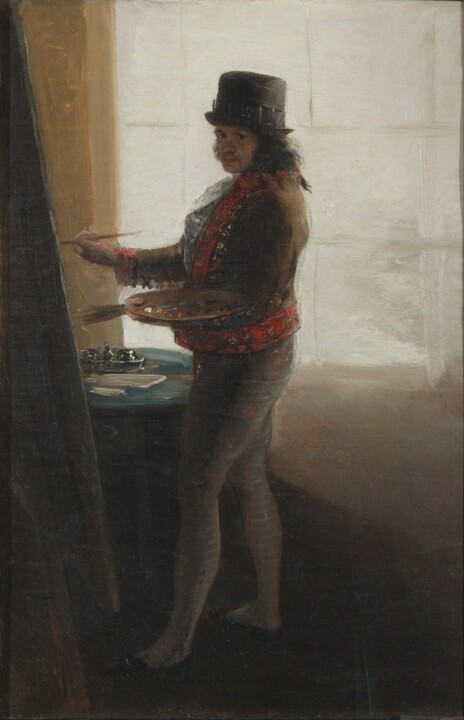 Francisco Goya, Self-portrait at an Easel, 1790-1795. Madrid: Real Academia de Bellas Artes de San Fernando.
Francisco Goya, Self-portrait at an Easel, 1790-1795. Madrid: Real Academia de Bellas Artes de San Fernando.
Who was Francisco Goya?
Francisco Goya was a Spanish painter and printmaker who lived from 1746 to 1828. He is considered one of the most important artists of the late 18th and early 19th centuries, and is particularly known for his paintings and prints depicting scenes of war, social injustice, and political corruption. Goya's works often dealt with difficult and controversial subjects, and he is credited with helping to usher in a new era of artistic expression and realism in Spain. Some of his most famous works include "The Third of May 1808," "The Naked Maja," and "The Black Paintings."
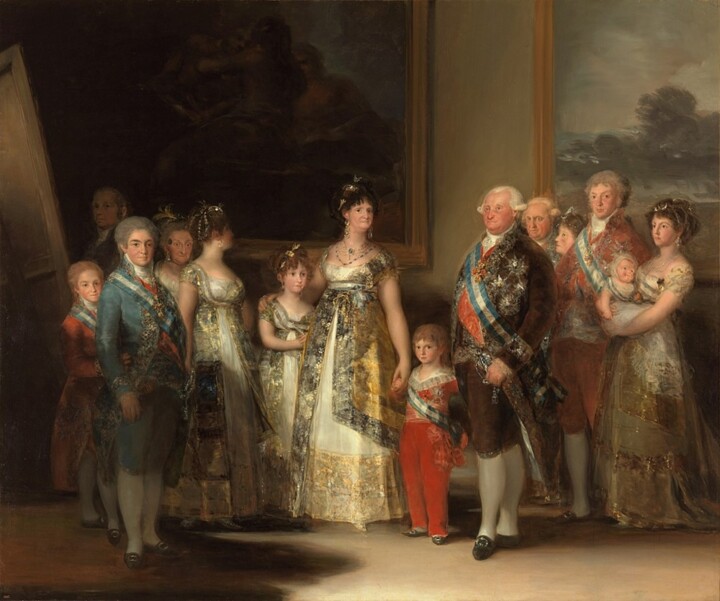 Francisco Goya, The Family of Charles IV, 1800-1801. Oil on canvas, 280×336 cm. Madrid: Museo del Prado.
Francisco Goya, The Family of Charles IV, 1800-1801. Oil on canvas, 280×336 cm. Madrid: Museo del Prado.
Francisco Goya's most famous paintings
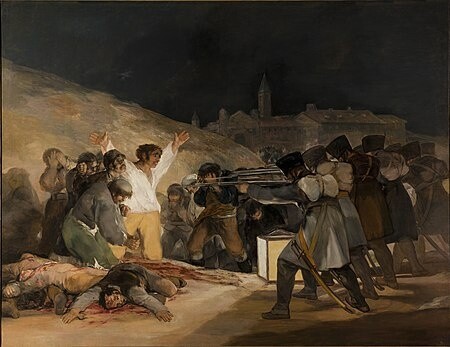 Francisco Goya, The Third of May 1808, 1814. Oil on canvas, 268×347 cm. Madrid: Museo del Prado.
Francisco Goya, The Third of May 1808, 1814. Oil on canvas, 268×347 cm. Madrid: Museo del Prado.
- The Third of May 1808 (1814): This painting depicts the execution of Spanish civilians by French soldiers during the Peninsular War. It is a powerful image of the horrors of war and has been hailed as one of the greatest anti-war paintings of all time.
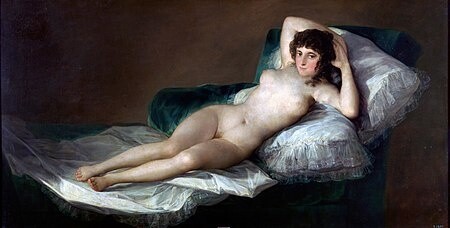 Francisco Goya, La maja desnuda, 1790-1800. Oil on canvas, 95×190 cm. Madrid: Museo del Prado.
Francisco Goya, La maja desnuda, 1790-1800. Oil on canvas, 95×190 cm. Madrid: Museo del Prado.
- The Nude Maja (c. 1797-1800): This painting is a provocative and sensual portrait of a reclining nude woman. It caused controversy when it was first exhibited due to its explicit nature, but it has since become one of Goya's most iconic works.
- The Black Paintings (c. 1819-1823): These are a series of fourteen murals that Goya painted directly onto the walls of his house near Madrid. They are haunting and disturbing images that explore themes of death, fear, and insanity.
- The Disasters of War (c. 1810-1820): This is a series of eighty etchings that depict the atrocities committed by both French and Spanish forces during the Peninsular War. They are a stark reminder of the human cost of conflict.
- Saturn Devouring His Son (c. 1819-1823): This is one of the most famous paintings from Goya's Black Paintings series. It is a gruesome and disturbing image of the Roman god Saturn consuming one of his own children, and it has been interpreted as a reflection of Goya's own fears and anxieties about mortality and the darker aspects of human nature.
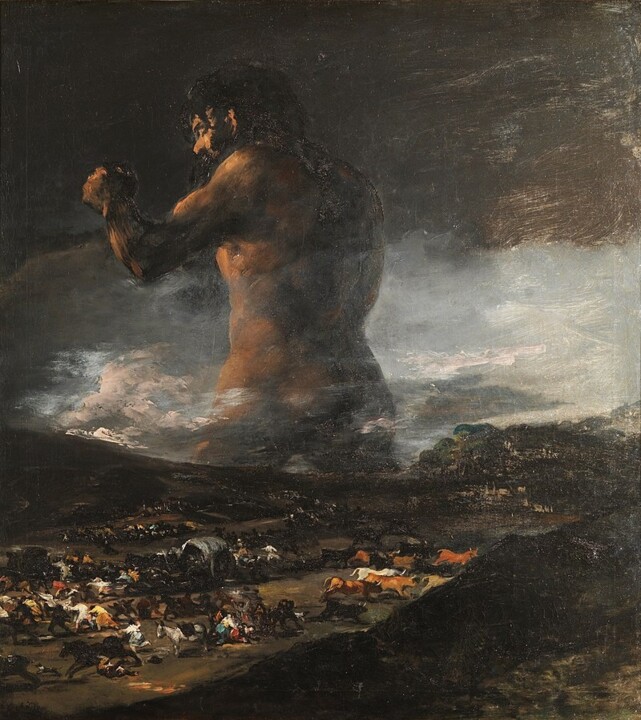 Francisco Goya, The Colossus, 1808. Oil on canvas, 116 × 105 cm. Madrid: Museo del Prado.
Francisco Goya, The Colossus, 1808. Oil on canvas, 116 × 105 cm. Madrid: Museo del Prado.
Stylistic characteristics
- Use of darkness and light: Goya's paintings often feature dramatic contrasts between dark and light areas, creating a sense of depth and drama. This technique is particularly evident in his famous series of Black Paintings, created towards the end of his life.
- Bold brushstrokes: Goya's paintings have a loose, fluid quality to them, with brushstrokes that are sometimes visible on the surface of the canvas. This technique gives his works a sense of energy and immediacy.
- Use of vivid colors: Goya was known for his use of bright, bold colors, particularly in his early works. Later in his career, he shifted towards a more muted palette, but his use of color always remained expressive and impactful.
- Interest in psychological and emotional states: Goya's works often explore the inner world of his subjects, depicting them in moments of fear, despair, or anguish. This interest in psychology and emotion is particularly evident in his series of prints, The Disasters of War.
- Emphasis on social commentary: Goya's works often critique the political and social norms of his time, particularly in his later works. His famous painting The Third of May 1808, for example, depicts the execution of Spanish citizens by French troops during the Napoleonic Wars, and serves as a powerful critique of the brutality of war and tyranny.
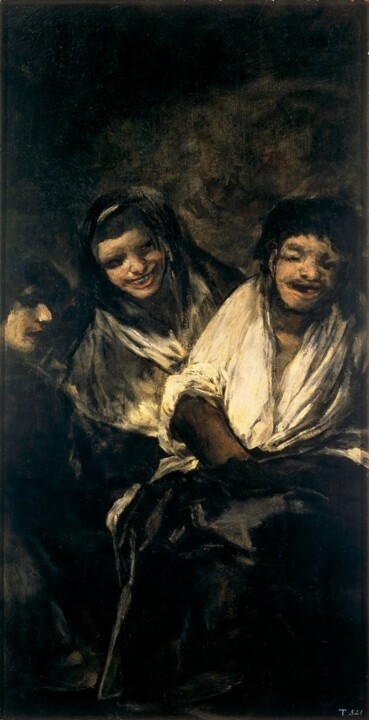 Francisco Goya, Man Mocked by Two Women, 1819–182. Oil on gesso transferred to linen, 125.4 cm × 65.4 cm. Madrid: Museo del Prado.
Francisco Goya, Man Mocked by Two Women, 1819–182. Oil on gesso transferred to linen, 125.4 cm × 65.4 cm. Madrid: Museo del Prado.
The late style
The late style of Francisco Goya is characterized by a shift towards a more expressionistic and somber approach to his subjects. He abandoned the neoclassical style that had been popular in his earlier works and began to experiment with more subjective and emotional interpretations of his subjects.
Goya's late paintings often feature distorted figures, dark colors, and dramatic contrasts of light and shadow. He also became more interested in exploring the darker aspects of human nature, such as madness, violence, and death.
The Black Paintings, which Goya painted directly onto the walls of his house in his final years, are perhaps the most iconic examples of his late style. These murals are haunting and unsettling, featuring grotesque and disturbing images that reflect Goya's personal anxieties and fears.
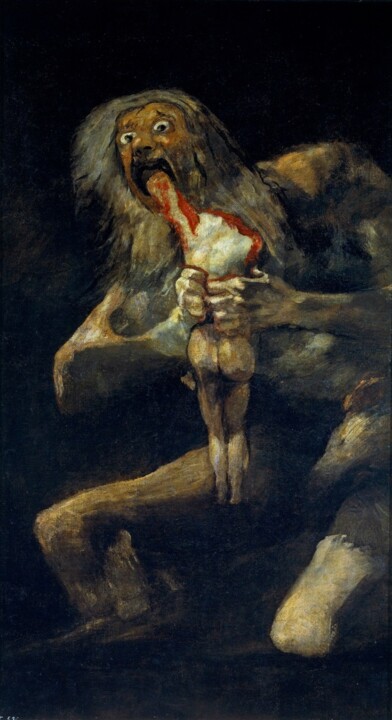 Francisco Goya, Saturn Devouring His Son, c. 1819–1823. Oil on canvas, 143.5 × 81.4 cm. Madrid: Museo del Prado.
Francisco Goya, Saturn Devouring His Son, c. 1819–1823. Oil on canvas, 143.5 × 81.4 cm. Madrid: Museo del Prado.
Saturn devouring his son by Francisco Goya
"Saturn Devouring His Son" is a painting by Francisco Goya that is part of his series of murals known as the Black Paintings. The painting depicts the mythological story of Saturn, the Roman god of agriculture, who ate his own children to prevent them from overthrowing him.
In the painting, Saturn is shown as a monstrous figure with a wild, crazed expression as he bites into the flesh of his son, who is shown in a contorted and twisted pose. The background is dark and ominous, adding to the overall sense of horror and violence.
The painting is executed in a loose and gestural style, with rough brushstrokes and an emphasis on texture and movement. This gives the painting a sense of immediacy and emotional intensity, emphasizing the brutal and gruesome nature of the subject matter.
"Saturn Devouring His Son" is considered one of Goya's most powerful and disturbing works, and it has been interpreted in various ways over the years, including as a commentary on political violence or as a reflection of the artist's own anxieties about mortality and the darker aspects of human nature.
Texture, lines, shapes, forms and space
The texture of the painting is rough and thick, with heavy impasto and visible brushstrokes. Goya used a technique called fresco-secco, which involves applying paint onto a dry plaster surface, to create the painting. This technique allowed him to build up layers of paint and create a heavily textured surface, which adds to the overall sense of horror and brutality in the painting. The use of a limited color palette and dramatic chiaroscuro lighting also contribute to the painting's unsettling atmosphere.
Saturn Devouring His Son by Francisco Goya is known for its strong, bold lines that create a sense of chaos and movement in the painting. Goya's use of sharp, jagged lines and angular forms contributes to the overall feeling of horror and violence in the scene. The lines are thick and heavily emphasized, adding to the painting's sense of depth. The use of strong diagonals also creates a sense of tension and unease in the composition.
In Saturn Devouring His Son by Francisco Goya, the shape of the painting is primarily rectangular, with the central figure of Saturn dominating the composition. The shape of Saturn's body is twisted and contorted, creating a sense of movement and violence that is echoed in the surrounding forms. The shapes of the other figures in the painting, including the small, vulnerable form of Saturn's son, are also distorted and twisted, contributing to the sense of horror and chaos in the scene.
The form in Saturn Devouring His Son by Francisco Goya is characterized by a strong sense of three-dimensionality and solidity. Goya used a technique called chiaroscuro to create a sense of depth and volume in the painting, with the central figure of Saturn appearing to emerge from the background in a dramatic and forceful manner. The use of thick, heavily impastoed paint also adds to the sense of physicality and substance in the painting.
The space in Saturn Devouring His Son by Francisco Goya is defined by a strong sense of claustrophobia and confinement. The figures in the painting are crowded into a tight, compressed space, with Saturn's massive body dominating the foreground and appearing to press in on the other figures. The use of dramatic lighting and strong contrasts of light and dark also contribute to the sense of confinement and darkness in the space. Goya's use of foreshortening and distorted perspective adds to the overall sense of unease and disorientation in the composition, creating a feeling of physical and psychological distortion.
The meaning
Saturn Devouring His Son by Francisco Goya is a disturbing and powerful painting that depicts the mythological tale of Saturn, who was warned that one of his children would overthrow him and began to devour his offspring to prevent this from happening. The painting is widely interpreted as a representation of the destructive power of tyranny, violence, and insanity. Goya painted the work during a period of political turmoil and violence in Spain, and many see the painting as a reflection of the horrors of war and the abuse of power.
The painting is also seen as a commentary on the destructive nature of patriarchy and the abuse of familial relationships. The figure of Saturn, who is both father and killer, represents the destructive power of patriarchal authority and the way in which it can turn against those it is meant to protect. In this interpretation, the painting is a powerful critique of the abuse of power and the need for individuals to resist oppressive structures and systems.
Saturn Devouring His Son is a deeply unsettling and powerful work of art that continues to resonate with viewers today, conveying a timeless message about the destructive power of tyranny and oppression.
Historical context
Saturn Devouring His Son by Francisco Goya was painted between 1819 and 1823, during a period of political and social turmoil in Spain. Goya had witnessed the horrors of the Peninsular War, which had raged across Spain for six years and resulted in the deaths of hundreds of thousands of people. The war had been fought between the French and Spanish armies, with many Spanish citizens forced to fight on both sides.
During this time, Spain was ruled by King Ferdinand VII, who was known for his repression of political dissent and his support for the Inquisition. Goya himself had been a court painter under Ferdinand VII, but he became disillusioned with the king's policies and the violence he had witnessed during the war.
Saturn Devouring His Son can be seen as a reflection of the violence and horror that Goya witnessed during this period, as well as a critique of the abuses of power and the destructive nature of patriarchy. The painting's themes of brutality, oppression, and insanity are all deeply relevant to the political and social context of Goya's time.
The painting is also significant for its departure from the neoclassical style that had dominated Spanish art during the 18th century. Goya's use of chiaroscuro and his expressive, emotional brushwork were a departure from the strict formalism of neoclassicism and foreshadowed the emergence of Romanticism in art.
Anecdotes
- The painting was never intended for public display. Goya painted it as a part of a series of Black Paintings on the walls of his house outside Madrid, which were not discovered until after his death.
- The painting was not named by Goya himself. The name "Saturn Devouring His Son" was given to it by art historians who were trying to identify the figures depicted in the Black Paintings.
- The painting has been interpreted in many different ways over the years. Some have seen it as a reflection of Goya's own fears and anxieties, while others have viewed it as a commentary on the destructive nature of power and authority.
- The painting was considered scandalous and controversial when it was first discovered. Some art critics were horrified by its graphic imagery and disturbing subject matter, while others praised its raw power and emotional intensity.
Where Is the Saturn Devouring His Son Painting?
The Museo del Prado in Madrid, Spain, is home to Francisco Goya's painting "Saturn Devouring His Son." The painting is part of the museum's permanent collection and can be viewed by visitors. The painting "Saturn Devouring His Son" by Francisco Goya became part of the Prado collection through a donation by the Spanish government in 1933. Prior to this, the painting was held in the private collection of the Duke and Duchess of Osuna. After their deaths, the painting changed hands several times before being acquired by the Spanish government and eventually placed in the Prado Museum's collection. Today, it is one of the most famous and recognizable works of art in the museum.
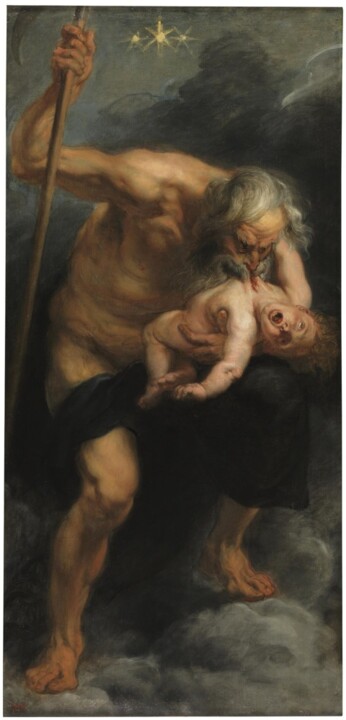 Peter Paul Rubens, Saturn, 1636. Madrid: Museo del Prado.
Peter Paul Rubens, Saturn, 1636. Madrid: Museo del Prado.
Who was Saturn?
In Roman mythology, Saturn (also known as Cronus in Greek mythology) was a god of agriculture and fertility. He was the son of Uranus and Gaia and the husband of his sister, Ops. According to myth, Saturn overthrew his father and became king of the gods, but he was warned that one of his own children would overthrow him. In order to prevent this from happening, Saturn began to devour his children as soon as they were born. However, his wife Ops managed to save one of their children, Jupiter (Zeus), who later went on to overthrow Saturn and become king of the gods.
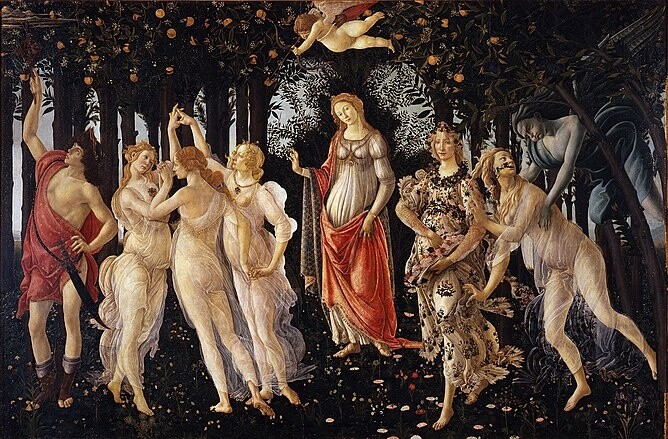 Sandro Botticelli: "The Allegory of Spring" (1482), which includes Saturn as one of the figures in the background.
Sandro Botticelli: "The Allegory of Spring" (1482), which includes Saturn as one of the figures in the background.
Saturn represented in art
Saturn has been represented in various ways throughout art history. In classical art, Saturn was often depicted as an elderly man with a scythe, representing the passage of time and the harvest. He was also sometimes depicted as a god of agriculture, with a cornucopia or other agricultural symbols.
In Renaissance and Baroque art, Saturn was often portrayed as a muscular, nude male figure with a long beard and flowing hair. He was often shown with a sickle or scythe, emphasizing his role as the god of time and death.
In modern times, Saturn is frequently depicted as a planet, either in scientific illustrations or in works of science fiction. In some contemporary art, Saturn's rings are emphasized, giving the planet a distinctive and otherworldly appearance.
 Giovanni Battista Tiepolo: Staircase of the Würzburg Residence, detail with Saturn.
Giovanni Battista Tiepolo: Staircase of the Würzburg Residence, detail with Saturn.
Other artists who painted Saturn
- Peter Paul Rubens: Saturn is a recurring motif in many of Rubens' works, often depicted as a powerful and imposing figure.
- Peter Bruegel the Elder: Bruegel painted a series of paintings featuring Saturn, including "Saturn Devouring his Children" and "The Triumph of Saturn."
- Diego Velázquez: Velázquez painted a portrait of Philip IV of Spain holding a statue of Saturn, which is thought to be a commentary on the king's power and the idea of the ruler as a devourer of his subjects.
- Francisco de Zurbarán: Zurbarán painted a number of works featuring Saturn, including "Saturn Devouring his Son" and "The Triumph of Saturn."
- Giovanni Battista Tiepolo: Tiepolo painted a series of ceiling frescoes in the Palazzo Labia in Venice, featuring Saturn as a symbol of time and mortality.


 Olimpia Gaia Martinelli
Olimpia Gaia Martinelli





